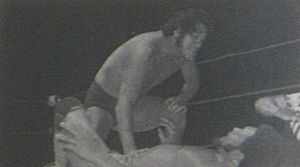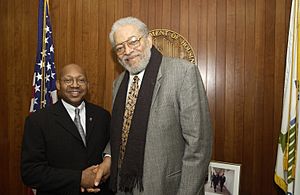Ernie Ladd facts for kids
Quick facts for kids
Ernie Ladd
|
|||||||
|---|---|---|---|---|---|---|---|

Ladd in 2004
|
|||||||
| Born |
Ernest Ladd
November 28, 1938 Rayville, Louisiana, U.S.
|
||||||
| Died | March 10, 2007 (aged 68) Franklin, Louisiana, U.S.
|
||||||
| Alma mater | Grambling State University | ||||||
| Spouse(s) | Roslyn Ladd | ||||||
| Children | 4 | ||||||
|
Professional wrestling career
|
|||||||
| Ring name(s) | Ernie Ladd | ||||||
| Billed height | 6 ft 9 in (2.06 m) | ||||||
| Billed weight | 324 lb (147 kg) | ||||||
| Billed from | New Orleans, Louisiana, U.S. | ||||||
| Trained by | Bobo Brazil | ||||||
| Debut | 1961 | ||||||
| Retired | 1986 | ||||||
|
Football career |
|||||||
| No. 77 | |||||||
| Position: | Defensive tackle | ||||||
| Personal information | |||||||
| Height: | 6 ft 9 in (2.06 m) | ||||||
| Weight: | 290 lb (132 kg) | ||||||
| Career information | |||||||
| College: | Grambling State | ||||||
| NFL Draft: | 1961 / Round: 4 / Pick: 48 (by the Chicago Bears) |
||||||
| AFL draft: | 1961 / Round: 7 / Pick: 119 | ||||||
| Career history | |||||||
|
|||||||
| Career highlights and awards | |||||||
|
|||||||
| Career NFL statistics | |||||||
|
|||||||
| Player stats at PFR | |||||||
Ernest Ladd (born November 28, 1938 – died March 10, 2007) was an amazing American athlete. He was known as "The Big Cat" because of his size and agility. Ernie Ladd played both professional American football and became a famous professional wrestler.
Ladd was a top athlete in high school. He went to Grambling State University on a basketball scholarship. In 1961, he was drafted by the San Diego Chargers. This team was part of the American Football League (AFL).
Ernie Ladd was one of the biggest players in football history. He stood 6 feet 9 inches tall and weighed 290 pounds. He helped the Chargers reach four AFL championship games. In 1963, his team won the championship. He also played for the Kansas City Chiefs and Houston Oilers.
During the football off-season, Ladd started professional wrestling. After a knee injury ended his football career, he became a full-time wrestler in 1969. As a wrestler, Ladd was known as a "heel." This means he played a villain character. He would often brag and tease his opponents and the fans.
Ladd had exciting rivalries with many popular wrestlers. These included Wahoo McDaniel, André the Giant, Bobo Brazil, and Dusty Rhodes. He retired from wrestling in 1986.
Ernie Ladd was honored many times for his sports career. He was inducted into the Los Angeles Chargers Hall of Fame in 1981. He also joined the Grambling State University Hall of Fame in 1989. In 1995, he was inducted into the WWF Hall of Fame.
Ladd was diagnosed with colon cancer in late 2003 or early 2004. He passed away from the illness on March 10, 2007, at 68 years old.
Contents
Early Life and College
Ernie Ladd was born in Rayville, Louisiana. He grew up in Orange, Texas. In high school, he was a star in both high school football and basketball. His football coach was William Ray Smith Sr. He was the father of another NFL star, Bubba Smith.
Ladd later attended Grambling State University. He went there on a basketball scholarship. His uncle, Garland Boyette, also played for Grambling and the Houston Oilers.
Professional Football Career
In 1961, Ernie Ladd was drafted by two different football leagues. The Chicago Bears picked him in the fourth round of the NFL Draft. The San Diego Chargers picked him in the AFL draft. Ladd chose to sign with the Chargers.
At 6 feet 9 inches and 290 pounds, Ladd was huge. Many said he was the biggest and strongest player in football at that time. His body measurements were impressive. He had a 52-inch chest and 20-inch biceps. He also wore size 18D shoes!
Ladd played in four AFL championship games. He helped the Chargers win the AFL title in 1963. He was part of the famous "Fearsome Foursome" with teammate Earl Faison.
From 1962 to 1965, Ladd was an AFL All-Star. In 1965, he helped organize a walkout at the AFL All-Star Game. This happened because of racism that players faced in New Orleans.
Ladd had some disagreements with the Chargers' team management. He eventually signed with the Houston Oilers for the 1966 season. In 1967, he moved to the Kansas City Chiefs. There, he played alongside another huge player, Buck Buchanan. Buchanan was also from Grambling. Together, they formed a very large defensive tackle team.
Boston Patriots center Jon Morris once described playing against Ladd. He said Ladd was so big it was "like being locked in a closet." In 1981, Ladd was inducted into the Los Angeles Chargers Hall of Fame.
Professional Wrestling Career
Ernie Ladd started wrestling in 1961. At first, it was a way to stay busy during the football off-season. He quickly became very popular. When knee problems ended his football career, Ladd became a full-time wrestler in 1969. Wrestling was more financially rewarding for him.
After being a "fan favorite" (a good guy), Ladd became a "heel" (a bad guy) in the 1970s. He was one of the first black wrestlers to play a villain. He would make crowds angry with his arrogant attitude. He often used funny, but sometimes rude, nicknames for his opponents. For example, he called André the Giant "Andre the Dummy" or "The Big Fat French Fry."
Ladd often used a taped thumb during matches. He claimed it was for an old football injury. But sometimes, when he was in trouble during a match, he would just walk out of the arena. He would accept a "countout loss." This move became known as "pulling an Ernie Ladd."
Ladd wrestled for many different wrestling groups. These included the World Wide Wrestling Federation (WWWF). He also had successful times in the NWA, Mid-South Wrestling, NWF, and WWC.
Because of his huge size and strength, Ladd often had rivalries with other giant wrestlers. His most famous feud was with André the Giant.
In some areas, Ladd's wrestling nickname was "The King." He would even wear a fancy crown. In other places, he was "The Big Cat." He would enter the ring wearing a large cowboy hat.
Ladd had many important matches. In 1976, he challenged Bruno Sammartino for the WWWF title. In 1978, he wrestled WWWF champion Bob Backlund.
After leaving the WWWF, Ladd went to the Mid-South territory. There, he had rivalries with wrestlers like Paul Orndorff and Junkyard Dog. He also helped manage Afa and Sika, known as The Wild Samoans. Ladd also worked as a "booker" behind the scenes. This meant he helped plan the wrestling storylines and matches.
Ladd retired from wrestling in 1986. This was due to his ongoing knee problems. He then returned to the WWF as a commentator. He talked about matches on TV shows like WWF Championship Wrestling. He also worked with Gorilla Monsoon and Johnny Valiant.
He wrestled one last match in 1988. It was a battle royal in Long Island, New York.
Ernie Ladd was inducted into the WCW Hall of Fame in 1994. He also joined the WWF Hall of Fame in 1995. He was the first person to be in both halls of fame.
Later Years
Ernie Ladd was a longtime friend of the Bush family. He supported George W. Bush in the 2000 presidential election.
Ladd also owned a BBQ restaurant in New Orleans, Louisiana. It was called Big Cat Ernie Ladd's "Throwdown" BBQ Restaurant. Sadly, it was destroyed by Hurricane Katrina in 2005. After the hurricane, he helped people who had to leave their homes. He also coached basketball for young kids in Franklin, Louisiana.
Ladd appeared on an episode of That '70s Show. He was in a locker room scene with The Rock. The Rock was playing his own father, "Soul Man" Rocky Johnson.
Death
Ernie Ladd was diagnosed with colon cancer in late 2003 or early 2004. Doctors told him he had only a few months to live. Ladd chose to stay positive and believed he would overcome it. The cancer eventually spread to his stomach and bones. He passed away on March 10, 2007, at the age of 68.
Championships and Accomplishments
- Cauliflower Alley Club
- Other honoree (2005)
- Central States Wrestling
- NWA Central States Tag Team Championship (1 time) – with Bruiser Brody
- Championship Wrestling from Florida
- NWA Florida Heavyweight Championship (1 time)
- NWA Southern Heavyweight Championship (Florida version) (1 time)
- Georgia Championship Wrestling
- NWA Georgia Tag Team Championship (1 time) – with Ole Anderson
- Hollywood Wrestling / Worldwide Wrestling Associates
- NWA Americas Heavyweight Championship (3 times)
- WWA International Television Tag Team Championship (1 time) – with Edouard Carpentier
- WWA World Tag Team Championship (1 time) – with Edouard Carpentier
- National Wrestling Alliance
- NWA Hall of Fame (Class of 2013)
- National Wrestling Federation
- NWF Brass Knuckles Championship (1 time)
- NWF Heavyweight Championship (1 time)
- NWF North American Heavyweight Championship (6 times)
- NWA Big Time Wrestling
- NWA American Heavyweight Championship (1 time)
- NWA Brass Knuckles Championship (Texas version) (1 time)
- NWA Texas Heavyweight Championship (1 time)
- NWA Tri-State / Mid-South Wrestling Association
- Mid-South Louisiana Heavyweight Championship (2 times)
- Mid-South North American Heavyweight Championship (1 time)
- Mid-South Tag Team Championship (2 times) – with Leroy Brown
- NWA Arkansas Heavyweight Championship (1 time)
- NWA North American Heavyweight Championship (Tri-State version) (5 times)
- NWA United States Tag Team Championship (Tri-State version) (1 time) – with The Assassin
- Pro Wrestling Illustrated
- PWI ranked him # 205 of the 500 best singles wrestlers during the "PWI Years" in 2003.
- Professional Wrestling Hall of Fame
- Class of 2018
- Southern California Pro-Wrestling Hall of Fame
- Inducted 2020
- World Championship Wrestling
- WCW Hall of Fame (Class of 1994)
- World Wrestling Association
- WWA World Heavyweight Championship (1 time)
- WWA World Tag Team Championship (1 time) – with Baron von Raschke
- World Wrestling Council
- WWC North American Heavyweight Championship (1 time)
- World Wrestling Federation
- WWF Hall of Fame (Class of 1995)
- Wrestling Observer Newsletter
- Wrestling Observer Newsletter Hall of Fame (Class of 1996)
See also
- List of American Football League players




